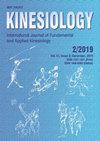Matching of personality traits, emotional intelligence and social skills among dance partners in competitive dancing
IF 0.9
4区 医学
Q4 REHABILITATION
引用次数: 1
Abstract
We investigated whether there is more matching in personality traits, emotional intelligence and social skills in better–performing dance couples than in their less successful counterparts and if better and worse dancers individually have more equivalent personality traits, emotional intelligence and social skill. 30 dance couples (i.e. 30 male and 30 female dancers) performing Latin and standard dances at a competitive level were included in the study. Among the measured metrics were: personality traits (using the Big Five Questionnaire), social skills (using the Interpersonal Skills Questionnaire) and emotional intelligence (using the Emotional Competence Questionnaire). When comparing differences between couples, results showed that better dance couples are more orderly, agreeable and conscientious than worse dance couples. Whereas worse dance couples seem to be more open. When comparing differences between dancers, results showed that better–performing dancers tend to be older, more experienced, with a higher »competitive mileage« and better–trained bodies, are more diligent, firmly believe in their success, are confident in attaining their goals and are more highly motivated. They are also more emotionally stable – a trait that stems from their maturity and long years of competing. Findings obtained by our study will certainly allow us to view competitive dancers from a different, as of yet undiscovered and potentially deeper viewpoint of psychology. One of the practical aspects of our research lies in understanding how to keep dance couples together longer, allowing dancers to perform in unison for longer periods than would be otherwise possible.竞技舞蹈中舞伴人格特征、情商和社交技巧的匹配
我们调查了表现较好的舞伴是否比表现较差的舞伴在性格特征、情商和社交技巧方面有更多的匹配,以及表现较好的舞者和表现较差的舞者是否在个性特征、情商和社交技巧方面有更多的相似之处。30对舞蹈搭档(即30名男舞者和30名女舞者)在竞技水平上表演拉丁舞和标准舞。测量的指标包括:人格特征(使用大五问卷)、社交技能(使用人际关系技能问卷)和情商(使用情绪能力问卷)。当比较夫妻之间的差异时,结果表明,舞跳得好的夫妇比舞跳得差的夫妇更有秩序、更随和、更认真。而糟糕的舞伴似乎更开放。当比较舞者之间的差异时,结果显示,表现更好的舞者往往年龄更大,经验更丰富,具有更高的“竞争里程”和受过更好训练的身体,更勤奋,坚定地相信自己的成功,有信心实现自己的目标,更有动力。他们的情绪也更稳定——这一特点源于他们的成熟和长期的竞争。我们的研究结果肯定会让我们从一个不同的,尚未被发现的,潜在的更深层次的心理学观点来看待竞争的舞者。我们研究的一个实际方面是了解如何让舞蹈伴侣在一起的时间更长,让舞者们在一起表演的时间更长。
本文章由计算机程序翻译,如有差异,请以英文原文为准。
求助全文
约1分钟内获得全文
求助全文
来源期刊

Kinesiology
REHABILITATION-SPORT SCIENCES
CiteScore
1.90
自引率
8.30%
发文量
16
审稿时长
>12 weeks
期刊介绍:
Kinesiology – International Journal of Fundamental and Applied Kinesiology (print ISSN 1331- 1441, online ISSN 1848-638X) publishes twice a year scientific papers and other written material from kinesiology (a scientific discipline which investigates art and science of human movement; in the meaning and scope close to the idiom “sport sciences”) and other adjacent human sciences focused on sport and exercise, primarily from anthropology (biological and cultural alike), medicine, sociology, psychology, natural sciences and mathematics applied to sport in its broadest sense, history, and others. Contributions of high scientific interest, including also results of theoretical analyses and their practical application in physical education, sport, physical recreation and kinesitherapy, are accepted for publication. The following sections define the scope of the journal: Sport and sports activities, Physical education, Recreation/leisure, Kinesiological anthropology, Training methods, Biology of sport and exercise, Sports medicine and physiology of sport, Biomechanics, History of sport and Book reviews with news.
 求助内容:
求助内容: 应助结果提醒方式:
应助结果提醒方式:


